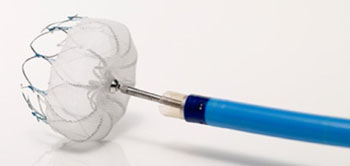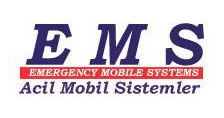Cardiac Closure Device Reduces Stroke Risk 
|
By HospiMedica International staff writers Posted on 05 Apr 2015 |
An innovative left atrial appendage (LAA) closure device assists high-risk patients with non-valvular atrial fibrillation (AF) who are seeking an alternative to long-term warfarin therapy.
The Watchman LAA closure system consists of a delivery catheter, an access sheath that serves as a conduit for the delivery catheter, and the LAA closure device itself, which is permanently implanted at or slightly distal to the ostium of the LAA, blocking it off to prevent thrombus embolization. The Watchman LAA is made of a nitinol frame with a polyethylene terephthalate (PET) membrane cap, and is available in five diameters (21, 24, 27, 30, and 33 mm); 10 active fixation anchors provide stability and retention. The access sheath is available in either a double or single curve distal tip.
A transesophageal echocardiogram (TEE) is first performed to determine device size. The placement procedure is performed in a catheterization laboratory, using standard transseptal technique. Once the inter-atrial septum is crossed, the access sheath is advanced over a guidewire into the left atrium and onto the distal portion of the LAA over a pigtail catheter. The Watchman is then advanced under fluoroscopic guidance and deployed into the LAA. The Watchman LAA closure device is a product of Boston Scientific (Natick, MA, USA), and has been approved by the US Food and Drug Administration (FDA).
“Boston Scientific is proud to offer this potentially life-changing stroke risk treatment option to high-risk patients with AF who have a reason to seek a non-drug alternative to warfarin,” said Joe Fitzgerald, executive vice president and president of rhythm management at Boston Scientific. “FDA approval of the Watchman device is another example of Boston Scientific delivering on its commitment to bring meaningful innovations to patient care.”
“The Watchman device is a breakthrough treatment providing those patients who are suitable for warfarin with an implant-based alternative to long-term warfarin therapy while still reducing the risk of stroke,” said Vivek Reddy, MD, director of the cardiac arrhythmia service at Mount Sinai Medical Center (Miami, FL, USA). “We know that up to 40% of patients who are eligible for oral anticoagulation do not take it for numerous reasons, highlighting the need for additional treatment options.”
The LAA is a small, ear-shaped sac in the muscle wall of the left atrium. In normal hearts, the heart contracts with each heartbeat, and the blood in the left atrium and LAA is squeezed out into the left ventricle. When a patient has AF, the chaotic impulses do not give the atria time to contract, and blood collects and can form clots in the LAA and atria. The LAA is thought to be the source of more than 90% of stroke-causing blood clots that come from the heart in non-valvular AF patients.
Related Links:
Boston Scientific
Mount Sinai Medical Center
The Watchman LAA closure system consists of a delivery catheter, an access sheath that serves as a conduit for the delivery catheter, and the LAA closure device itself, which is permanently implanted at or slightly distal to the ostium of the LAA, blocking it off to prevent thrombus embolization. The Watchman LAA is made of a nitinol frame with a polyethylene terephthalate (PET) membrane cap, and is available in five diameters (21, 24, 27, 30, and 33 mm); 10 active fixation anchors provide stability and retention. The access sheath is available in either a double or single curve distal tip.
A transesophageal echocardiogram (TEE) is first performed to determine device size. The placement procedure is performed in a catheterization laboratory, using standard transseptal technique. Once the inter-atrial septum is crossed, the access sheath is advanced over a guidewire into the left atrium and onto the distal portion of the LAA over a pigtail catheter. The Watchman is then advanced under fluoroscopic guidance and deployed into the LAA. The Watchman LAA closure device is a product of Boston Scientific (Natick, MA, USA), and has been approved by the US Food and Drug Administration (FDA).
“Boston Scientific is proud to offer this potentially life-changing stroke risk treatment option to high-risk patients with AF who have a reason to seek a non-drug alternative to warfarin,” said Joe Fitzgerald, executive vice president and president of rhythm management at Boston Scientific. “FDA approval of the Watchman device is another example of Boston Scientific delivering on its commitment to bring meaningful innovations to patient care.”
“The Watchman device is a breakthrough treatment providing those patients who are suitable for warfarin with an implant-based alternative to long-term warfarin therapy while still reducing the risk of stroke,” said Vivek Reddy, MD, director of the cardiac arrhythmia service at Mount Sinai Medical Center (Miami, FL, USA). “We know that up to 40% of patients who are eligible for oral anticoagulation do not take it for numerous reasons, highlighting the need for additional treatment options.”
The LAA is a small, ear-shaped sac in the muscle wall of the left atrium. In normal hearts, the heart contracts with each heartbeat, and the blood in the left atrium and LAA is squeezed out into the left ventricle. When a patient has AF, the chaotic impulses do not give the atria time to contract, and blood collects and can form clots in the LAA and atria. The LAA is thought to be the source of more than 90% of stroke-causing blood clots that come from the heart in non-valvular AF patients.
Related Links:
Boston Scientific
Mount Sinai Medical Center
Read the full article by registering today, it's FREE! 

Register now for FREE to HospiMedica.com and get access to news and events that shape the world of Hospital Medicine. 
- Free digital version edition of HospiMedica International sent by email on regular basis
- Free print version of HospiMedica International magazine (available only outside USA and Canada).
- Free and unlimited access to back issues of HospiMedica International in digital format
- Free HospiMedica International Newsletter sent every week containing the latest news
- Free breaking news sent via email
- Free access to Events Calendar
- Free access to LinkXpress new product services
- REGISTRATION IS FREE AND EASY!
Sign in: Registered website members
Sign in: Registered magazine subscribers
Latest Surgical Techniques News
- Minimally Invasive Endoscopic Surgery Improves Severe Stroke Outcomes
- Novel Glue Prevents Complications After Breast Cancer Surgery
- Breakthrough Brain Implant Enables Safer and More Precise Drug Delivery
- Bioadhesive Sponge Stops Uncontrolled Internal Bleeding During Surgery
- Revolutionary Nano Bone Material to Accelerate Surgery and Healing
- Superior Orthopedic Implants Combat Infections and Quicken Healing After Surgery
- Laser-Based Technique Eliminates Pancreatic Tumors While Protecting Healthy Tissue
- Surgical Treatment of Severe Carotid Artery Stenosis Benefits Blood-Brain Barrier
- Revolutionary Reusable Duodenoscope Introduces 68-Minute Sterilization
- World's First Transcatheter Smart Implant Monitors and Treats Congestion in Heart Failure
- Hybrid Endoscope Marks Breakthrough in Surgical Visualization
- Robot-Assisted Bronchoscope Diagnoses Tiniest and Hardest to Reach Lung Tumors
- Diamond-Titanium Device Paves Way for Smart Implants that Warn of Disease Progression
- 3D Printable Bio-Active Glass Could Serve as Bone Replacement Material
- Spider-Inspired Magnetic Soft Robots to Perform Minimally Invasive GI Tract Procedures
- Micro Imaging Device Paired with Endoscope Spots Cancers at Earlier Stage
Channels
Critical Care
view channel
Light-Based Technology to Measure Brain Blood Flow Could Diagnose Stroke and TBI
Monitoring blood flow in the brain is crucial for diagnosing and treating neurological conditions such as stroke, traumatic brain injury (TBI), and vascular dementia. However, current imaging methods like... Read more
AI Heart Attack Risk Assessment Tool Outperforms Existing Methods
For decades, doctors have relied on standardized scoring systems to assess patients with the most common type of heart attack—non-ST-elevation acute coronary syndrome (NSTE-ACS). The GRACE score, used... Read morePatient Care
view channel
Revolutionary Automatic IV-Line Flushing Device to Enhance Infusion Care
More than 80% of in-hospital patients receive intravenous (IV) therapy. Every dose of IV medicine delivered in a small volume (<250 mL) infusion bag should be followed by subsequent flushing to ensure... Read more
VR Training Tool Combats Contamination of Portable Medical Equipment
Healthcare-associated infections (HAIs) impact one in every 31 patients, cause nearly 100,000 deaths each year, and cost USD 28.4 billion in direct medical expenses. Notably, up to 75% of these infections... Read more
Portable Biosensor Platform to Reduce Hospital-Acquired Infections
Approximately 4 million patients in the European Union acquire healthcare-associated infections (HAIs) or nosocomial infections each year, with around 37,000 deaths directly resulting from these infections,... Read moreFirst-Of-Its-Kind Portable Germicidal Light Technology Disinfects High-Touch Clinical Surfaces in Seconds
Reducing healthcare-acquired infections (HAIs) remains a pressing issue within global healthcare systems. In the United States alone, 1.7 million patients contract HAIs annually, leading to approximately... Read moreHealth IT
view channel
Printable Molecule-Selective Nanoparticles Enable Mass Production of Wearable Biosensors
The future of medicine is likely to focus on the personalization of healthcare—understanding exactly what an individual requires and delivering the appropriate combination of nutrients, metabolites, and... Read moreBusiness
view channel
Philips and Masimo Partner to Advance Patient Monitoring Measurement Technologies
Royal Philips (Amsterdam, Netherlands) and Masimo (Irvine, California, USA) have renewed their multi-year strategic collaboration, combining Philips’ expertise in patient monitoring with Masimo’s noninvasive... Read more
B. Braun Acquires Digital Microsurgery Company True Digital Surgery
The high-end microsurgery market in neurosurgery, spine, and ENT is undergoing a significant transformation. Traditional analog microscopes are giving way to digital exoscopes, which provide improved visualization,... Read more
CMEF 2025 to Promote Holistic and High-Quality Development of Medical and Health Industry
The 92nd China International Medical Equipment Fair (CMEF 2025) Autumn Exhibition is scheduled to be held from September 26 to 29 at the China Import and Export Fair Complex (Canton Fair Complex) in Guangzhou.... Read more











.jpg)




